Travel Through Afghanistan on a Harley-Davidson
By Peter Forwood
Afghanistan on a Harley (9/8/05 - 23/8/05)
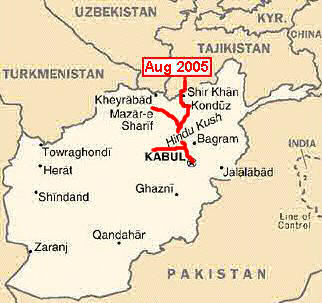
Distance 1485 km (435280 km to 436765 km)
This is part of the eleventh section of my around the
world trip.
Complete
Trip Overview & Map
Coming from Tajikistan
9/8/05 Two small boats pushed and pulled the vehicle ferry,
two trucks, two cars, and a motorcycle, across the river. My fare, $US
20.00, ten for me, ten for the motorcycle. The sun scorching through my
hat and radiating off the metal deck as we waited in over 40 degrees to
be cleared to leave the barge. A dusty kilometre had me at the check post
for immigration and customs where I waited a few minutes till afternoon
prayer was finished and the immigration officer politely stamped my passport
and I headed out of this dilapidated border post towards Kunduz 60 km
south. I was surprised by an asphalt road all the way, across the flat
dusty desert, with camels and donkeys carting fodder from the little grass
and bushes that grow there into the small settlements that dot the region.
Again the midday heat oppressive under my black helmet as I saw goats
resting in the shade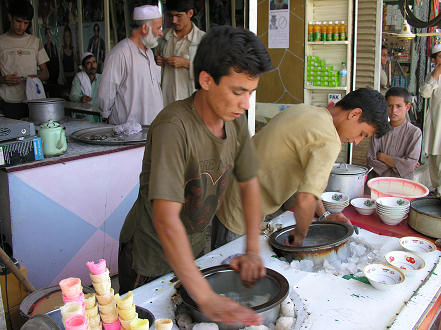 of the new electrical posts, the only shade. Each village had
a sign, an aid agency, helping with housing or agriculture, different
village, different aid agency. Closer to Kunduz, irrigation occurs, not
only water for plants but for boys swimming and playing in the canals.
It was to be quite some time before I saw a woman, and then it was under
the Burka, the all encompassing robe that covers the face, and the eyes
see only through a cloth mesh. I decided to stay in Kunduz for the night
having been advised not to travel into the evening. I had also been advised
not to wander off the road, even to toilet, as over 100 injuries a month
still occur due to exploding mines and shells.
of the new electrical posts, the only shade. Each village had
a sign, an aid agency, helping with housing or agriculture, different
village, different aid agency. Closer to Kunduz, irrigation occurs, not
only water for plants but for boys swimming and playing in the canals.
It was to be quite some time before I saw a woman, and then it was under
the Burka, the all encompassing robe that covers the face, and the eyes
see only through a cloth mesh. I decided to stay in Kunduz for the night
having been advised not to travel into the evening. I had also been advised
not to wander off the road, even to toilet, as over 100 injuries a month
still occur due to exploding mines and shells.
10/8/05 There is so much new and different here that the
decision to stay another day was easy. I had enjoyed local made ice cream
yesterday, made by rotating, by hand, large steel tubs, back and forth,
in a bath of ice. The ice cream freezing to the insides of the drum.
Dinner was brought to me sitting outside the hotel. Breakfast this morning
was relaxedly sitting on a raised platform, sipping sweet tea, eating
flat bread, and kebabs (meat and pieces of fat from the fat tailed sheep).
I, as much as the locals are to me, am a novelty. Polite smiles everywhere,
people happy to have their photo taken, prohibited under Taliban, enormous
opportunities for character photos.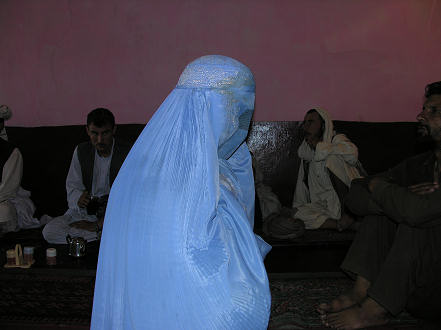 However there is an underlying tension. I have seen three street
arguments, one resulting in a blow. Armed police and military patrol
the streets and my hotel has an armed guard protecting the vehicles at
night. Television, also banned under the Taliban, is now in most restaurants,
belly dancers or sports the common theme. There is surprisingly, a lot
of English spoken, and I was guided to change money, easy at almost any
shop, (people wanting cash dollars to buy imported goods), and the internet,
by a friendly English speaking local. My guide informed me that women
were not allowed in the streets under the Taliban unless they had an emergency,
eg medical, but even now only about 5 per cent of people I have seen are
women, and of those 90 per cent still use the burka, the others, almost
exclusively older ladies, might have a head scarf or chador. I sat outside
the restaurant, and feeling quite inconspicuous, took many photographs
of passers-by, and without exception those noticing me photographing them
were comfortable with being photographed. A stroll through the market streets
revealed no women shopkeepers or workers. It is less than four years since
the Taliban fell and things move
However there is an underlying tension. I have seen three street
arguments, one resulting in a blow. Armed police and military patrol
the streets and my hotel has an armed guard protecting the vehicles at
night. Television, also banned under the Taliban, is now in most restaurants,
belly dancers or sports the common theme. There is surprisingly, a lot
of English spoken, and I was guided to change money, easy at almost any
shop, (people wanting cash dollars to buy imported goods), and the internet,
by a friendly English speaking local. My guide informed me that women
were not allowed in the streets under the Taliban unless they had an emergency,
eg medical, but even now only about 5 per cent of people I have seen are
women, and of those 90 per cent still use the burka, the others, almost
exclusively older ladies, might have a head scarf or chador. I sat outside
the restaurant, and feeling quite inconspicuous, took many photographs
of passers-by, and without exception those noticing me photographing them
were comfortable with being photographed. A stroll through the market streets
revealed no women shopkeepers or workers. It is less than four years since
the Taliban fell and things move slowly in traditional societies, and more slowly in rural areas,
but the women here seem to be taking a slow pace to their freedoms.
slowly in traditional societies, and more slowly in rural areas,
but the women here seem to be taking a slow pace to their freedoms.
11/8/05 Kabul is about 350 km. About, as my repaired speedometer
drive wheel broke along the way. The new asphalt road initially across
desert plains of high mud walled family compounds, most being repaired
or extended skywards in the dry season. Larger settlements existed
along waterways, where irrigation ditches funnelled the snow melt rivers
to potatoes, beans, corn, or fruit trees. The 3300 metre high Salang Pass
through a 6 km tunnel at the top had areas cordoned off with red and white
stones, and signs showing the mined areas. The sheep and goats grazing
the mountain summer pastures are however colour blind to the warnings.
This was the main access road for the Russians and saw much fighting against
Afghan resistance movements. The sides of the road are also littered with
tanks and military equipment. I was surprised at the volume of traffic. Trucks,
busses and left and right hand drive Japanese cars, has been, models. The
driving generally was bad, almost everyone new to the experience, and with
a high speed road the general rule for many, particularly share taxi's,
was to drive as fast as the car and road would allow. Consequently towns had inserted speed humps to slow vehicles, hundreds
of them. The first ISAF (International Security Assistance Force) personnel
I saw was at an accident, a taxi, always overloaded, crumpled against
a massive 4x4, no seat belts, likely no survivors. ISAF seemed to be just
ensuring the crowd didn't get out of control. Kabul is a busy, dusty, thriving
city in a bowl surrounded by mountains. I haven't seen a native tree, only
planted ones. The houses run up the mountains, built of the same coloured
earth, covered in the same dust they disappear into the haze. I finally
found the Park Hotel, the third I had looked at in traffic jammed downtown,
with motorcycle parking, and like most things here, without the soft touch
and cleanliness of a woman's hand, it is drab, rooms and bathrooms uncleaned
and no maintenance, and
the one sheet on the bed is probably no cleaner than when the last man slept
on it.
Consequently towns had inserted speed humps to slow vehicles, hundreds
of them. The first ISAF (International Security Assistance Force) personnel
I saw was at an accident, a taxi, always overloaded, crumpled against
a massive 4x4, no seat belts, likely no survivors. ISAF seemed to be just
ensuring the crowd didn't get out of control. Kabul is a busy, dusty, thriving
city in a bowl surrounded by mountains. I haven't seen a native tree, only
planted ones. The houses run up the mountains, built of the same coloured
earth, covered in the same dust they disappear into the haze. I finally
found the Park Hotel, the third I had looked at in traffic jammed downtown,
with motorcycle parking, and like most things here, without the soft touch
and cleanliness of a woman's hand, it is drab, rooms and bathrooms uncleaned
and no maintenance, and
the one sheet on the bed is probably no cleaner than when the last man slept
on it.
12/8/05 Women in Kabul are less conservative than in the
country areas. About half don't wear the burka, a head scarf, showing
varying amounts of hair though is still essential.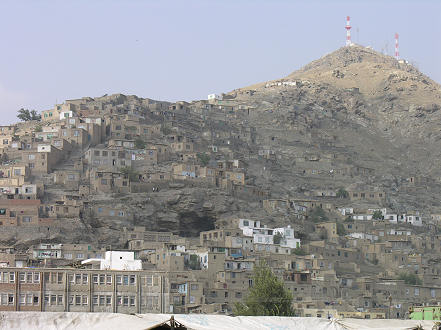 High heels, lace stockings (seen only below the ankle), and nail
polish appearing. Some will walk alone, but still a long way from a
mini skirt, if that is actually desired? Older men have the traditional
fist length beard, and turban with the loose flowing pants and top. Younger
men wear anything from the above to full western dress, any combination
seems acceptable. Cigarettes are rarely smoked, crushed tobacco is held
under the tongue, spitting is common. I visited the old 1970's area of
Kabul, part of the hippy trail, Chicken St and the Mustafa Hotel. Chicken
Street is a fairly dead place on a Friday holiday, half the shops are shut,
those that are open sell the same products of 35 years ago, carpets, jewellery
and semi historical artefacts, although the chicken shops are now gone, but
the street kids are about trying their luck at begging, selling books or
newspapers or even offering to be your security for a fee. There were a few
group tourists but most of the business is reportedly from NGO's and international
forces. It is easy to compare the differences that war has caused here as
opposed to Khao San Rd in Bangkok, that has continued to grow year on year
since its 1970's beginnings. I am not sure if the Mustafa Hotel is the
same, a quite modern hotel, still attracting the westerners and locals
alike. One of the few places
High heels, lace stockings (seen only below the ankle), and nail
polish appearing. Some will walk alone, but still a long way from a
mini skirt, if that is actually desired? Older men have the traditional
fist length beard, and turban with the loose flowing pants and top. Younger
men wear anything from the above to full western dress, any combination
seems acceptable. Cigarettes are rarely smoked, crushed tobacco is held
under the tongue, spitting is common. I visited the old 1970's area of
Kabul, part of the hippy trail, Chicken St and the Mustafa Hotel. Chicken
Street is a fairly dead place on a Friday holiday, half the shops are shut,
those that are open sell the same products of 35 years ago, carpets, jewellery
and semi historical artefacts, although the chicken shops are now gone, but
the street kids are about trying their luck at begging, selling books or
newspapers or even offering to be your security for a fee. There were a few
group tourists but most of the business is reportedly from NGO's and international
forces. It is easy to compare the differences that war has caused here as
opposed to Khao San Rd in Bangkok, that has continued to grow year on year
since its 1970's beginnings. I am not sure if the Mustafa Hotel is the
same, a quite modern hotel, still attracting the westerners and locals
alike. One of the few places a beer can be had on a Friday, internet and expensive western meals.
a beer can be had on a Friday, internet and expensive western meals.
13/8/05 Afghan hygiene is not that great, probably on
a par with India or Pakistan. I paid the price of being too casual, enjoying
the fresh fruits and kebabs, probably not thoroughly cooked, and spent
from late yesterday evening throughout today on my bed only leaving
it for a squat on the eastern style toilet. The electricity in the city
is not consistent, power was off from 8 am till 1 pm, at other times it
might be off for an hour or two, almost all small shops have a generator.
These days as soon as I realize I have a bad case of travellers diarrhoea
I start on antibiotics. The symptoms are usually gone then in 24 to 36 hours,
sometimes less. Particularly travelling alone there is no desire to try
to fight it off only to find after a couple of days that I am dehydrated,
not improving and perhaps need hospitalization and a drip.
14/8/05 Weak, but with the symptoms gone, today was light
duties. I may have met "The Bookseller of Kabul" at his bookstore, a
book I have recently read. I didn't ask if it was him as it would have
been impolite. The work by the Norwegian writer brought considerable criticism
for him.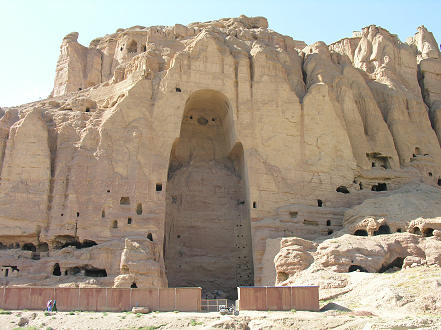 He spoke good English, was of a similar age and certainly had the
quick mind to be the same man. We discussed the book abstractly, and whilst
he denied having read it, he certainly had a great knowledge of its background.
He was pleased to hear my view that the writer seemed to take a particular
feminist angle and that I considered it inappropriate to write such a book
after being invited to live in his home. I purchased a couple of western
novels, reprints from Pakistan, at a discount, which he told me he has never
before given.? The rest of the day was spent at the Mustafa Hotel, photographers,
journalists, NGO's and one other tourist.
He spoke good English, was of a similar age and certainly had the
quick mind to be the same man. We discussed the book abstractly, and whilst
he denied having read it, he certainly had a great knowledge of its background.
He was pleased to hear my view that the writer seemed to take a particular
feminist angle and that I considered it inappropriate to write such a book
after being invited to live in his home. I purchased a couple of western
novels, reprints from Pakistan, at a discount, which he told me he has never
before given.? The rest of the day was spent at the Mustafa Hotel, photographers,
journalists, NGO's and one other tourist.
15/8/05 "There is no truth, just opinion, and to believe
there is a truth closes the mind to alternatives, with the possibility
of fundamentalism". Two roads lead to Bamiyan. The southern road a few
years ago was preferred but now it is considered dangerous. The road to
the north, which I took, retraces my arrival route for the first 75 km,
then heads left for the 160 km of rough stony road to Bamiyan. Afghanistan
is heavily populated with mobile people. The roads are busy, even this one
which with a few sadistic days journey could have you across the country
to Herat. I was the fastest moving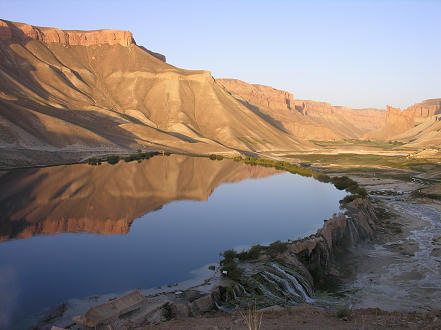 vehicle on the road but could only manage to average 25 km/hr plus
stops, taking eight hours total from Kabul. Again the road followed small
rivers with any flat land cultivated with irrigated snow melt. Bamiyan
is a one street town and I was welcomed by the ISAF soldiers from New Zealand
driving their Hummer, decked out with all the military hardware. The light
on the two enormous Buddha Niches, one 38 metres high the other 55 metres,
was perfect and I rode the motorcycle to their bases for a photograph.
The Buddha themselves, having survived for 1500 years since their construction
in the 6th century, only to be totally destroyed by the Taliban just four
years ago, just months before their government was overthrown. Conservation
work is being done on the remnants, very little, the rubble is being removed.
vehicle on the road but could only manage to average 25 km/hr plus
stops, taking eight hours total from Kabul. Again the road followed small
rivers with any flat land cultivated with irrigated snow melt. Bamiyan
is a one street town and I was welcomed by the ISAF soldiers from New Zealand
driving their Hummer, decked out with all the military hardware. The light
on the two enormous Buddha Niches, one 38 metres high the other 55 metres,
was perfect and I rode the motorcycle to their bases for a photograph.
The Buddha themselves, having survived for 1500 years since their construction
in the 6th century, only to be totally destroyed by the Taliban just four
years ago, just months before their government was overthrown. Conservation
work is being done on the remnants, very little, the rubble is being removed.
16/8/05 Four backpackers were staying at my hotel. Travellers
having just visited India, Pakistan and now teamed up for Afghanistan,
were the only tourists I saw in town. We agreed to charter a car to the lakes
of Band-e Amir, just 75 km, two hours thirty minutes away. These lakes are
natural, the dam wall is formed by the evaporation and depositing of minerals,
slowly building to over ten metre high and holding back large bodies of water
in the gorge. The water, a deep blue colour in stark contrast to the barren
mountains.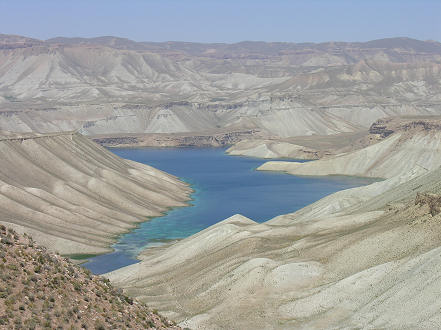 A pilgrimage site, slowly a local tourist place and a couple of westerners.
This year there are more facilities and we stayed the night in a flat roofed
mud brick room, sleeping on mats on the floor. At 2900 metres the season
is short, less than three months and the air cold, crisp and clear. Locals
were out with their donkeys collecting summer grasses for fuel and stock
feed over winter.
A pilgrimage site, slowly a local tourist place and a couple of westerners.
This year there are more facilities and we stayed the night in a flat roofed
mud brick room, sleeping on mats on the floor. At 2900 metres the season
is short, less than three months and the air cold, crisp and clear. Locals
were out with their donkeys collecting summer grasses for fuel and stock
feed over winter.
17/8/05 There are a series of five lakes, a boat runs to
the second one where it is a short walk to view the others. Each is different,
shallow sandy shore for swimming, shrubbery growing along the banks or
suddenly deep behind the wall, each incredibly beautiful. The boat ferries
local tourists for a days picnic and swim. By lunch time I had headed back
towards Bamiyan, the others having decided to stay a few more days before
moving towards Herat. ISAF and aid agencies play a low key role in that I
don't see them other than at work. They are not in the towns or restaurants
thus having a low profile and not accidentally offending locals values.
18/8/05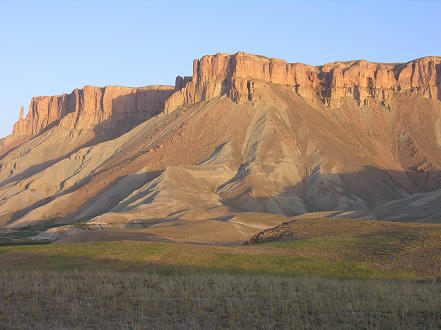 Something in this country I find difficult art
the stares. Even in areas where I would have expected enough tourists to
have watered down the novelty locals take long looks at me, and would be
considered by us as being an impolite length of time to look. I walked over
to the Buddha niches, surrounded by caves, a newer town exists where some
people still live in caves or at the base of the cliff, another ruins of
mud brick houses and the more modern town, still of mud brick all show an
incredibly long history in this valley and part of the old silk road.
Something in this country I find difficult art
the stares. Even in areas where I would have expected enough tourists to
have watered down the novelty locals take long looks at me, and would be
considered by us as being an impolite length of time to look. I walked over
to the Buddha niches, surrounded by caves, a newer town exists where some
people still live in caves or at the base of the cliff, another ruins of
mud brick houses and the more modern town, still of mud brick all show an
incredibly long history in this valley and part of the old silk road.
19/8/05 The road out the same as the road in, 6 hours
early morning, past the couple of dozen tank carcasses that litter the roadside
giving testament to mans destruction of himself. Once back on the highway
I headed north towards Mazar-e Sharif. I have often wondered what would
happen if the vehicle coming the other way couldn't negotiate the corner
and ended up on my side of the road facing me as I leaned into the corner.
Well today I found out. A taxi with five people were heading straight for
me, on my side of the road, as I stood the bike up in the corner to avoid
it,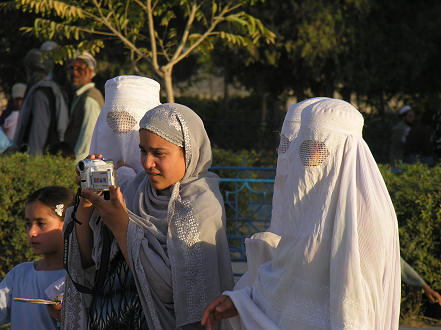 veering towards the edge of the road, its mirror smashed into the fairing,
and its side hit the back end of the motorcycle ripping open the fibreglass
pannier. A glancing blow, I skidded to a halt on the thankfully wide roadside
amongst rocks. The car did not stop. After a few seconds to recompose and
restart the motorcycle I pursued the car. Apologies and asking for forgiveness
from the driver was not sufficient as I figured I was within 20 cm of being
dead had I hit him head on. Another vehicle escorted us to the police station
where over a lengthy three hours, revisiting the accident scene, seeing
the debris on my side of the road and the skid marks put the car driver
completely in the wrong with damages of $US 100.00 to be paid for my damages.
The driver did not have the money. The police officer in charge and another
official offered to pay me, the driver would have to reimburse them. By
now it was dark and I was offered a place in the police compound to camp
the night. The car driver had to remain also at the police compound with
the car while his friends tried to find the money. The $US 100.00 will not
go close to paying for the damages, a new pannier, but is more than most
people here, including the police officer, earn in two months. I was pleased
with the way the police
veering towards the edge of the road, its mirror smashed into the fairing,
and its side hit the back end of the motorcycle ripping open the fibreglass
pannier. A glancing blow, I skidded to a halt on the thankfully wide roadside
amongst rocks. The car did not stop. After a few seconds to recompose and
restart the motorcycle I pursued the car. Apologies and asking for forgiveness
from the driver was not sufficient as I figured I was within 20 cm of being
dead had I hit him head on. Another vehicle escorted us to the police station
where over a lengthy three hours, revisiting the accident scene, seeing
the debris on my side of the road and the skid marks put the car driver
completely in the wrong with damages of $US 100.00 to be paid for my damages.
The driver did not have the money. The police officer in charge and another
official offered to pay me, the driver would have to reimburse them. By
now it was dark and I was offered a place in the police compound to camp
the night. The car driver had to remain also at the police compound with
the car while his friends tried to find the money. The $US 100.00 will not
go close to paying for the damages, a new pannier, but is more than most
people here, including the police officer, earn in two months. I was pleased
with the way the police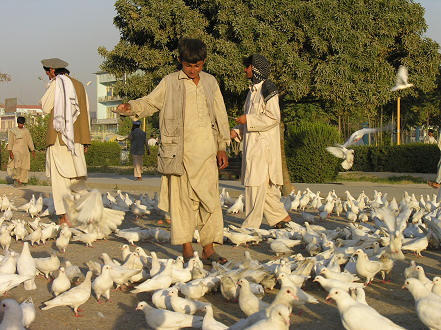 handled the matter but have mixed feelings regarding the damage or whether
the car driver could pay the compensation. Had he stopped after the accident
or been more honest in the dealings with the police rather than trying to
lie, I may have been more conciliatory.
handled the matter but have mixed feelings regarding the damage or whether
the car driver could pay the compensation. Had he stopped after the accident
or been more honest in the dealings with the police rather than trying to
lie, I may have been more conciliatory.
20/8/05 I felt more cautious and nervous heading out this
morning for two reasons, the traffic, but also because I was heading for
Mazar-e Sharif, where the driver and his friends lived, unsure of their
positions in that community or feelings towards me. The driver and car
were still being held at the police station awaiting funds to reimburse
the police officer. Back on the lowlands the morning rapidly became hot.
There is a total lack of shade in the country, low 40's and no natural shade
makes resting roadside a business transaction, purchasing a drink. The road
was good till the last few km's where it is not finished, hot and dusty
I arrived to a hot and dusty city. The area was Alexander the Greats Central
Asian capital, was on the silk road, Jenghis Khan destroyed the region on
his rampages and Marco Polo passed through on his journey of discovery.
There is little left to see for all this history. Mazar-e Sharif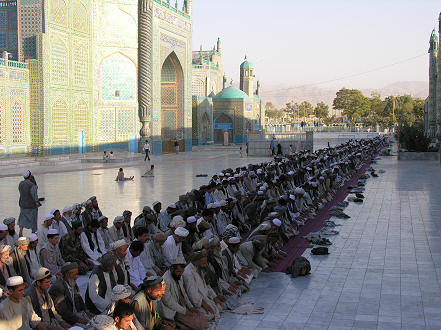 itself dates to the 15th century when a mullah reportedly discovered
the tomb of Ali, son-in-law of the prophet Mohammed, a tomb now the centre
of a grand mosque, and a worshiping place for all Muslims. The city itself
is currently stable but has recently been fought over by warlords wanting
to increase their control of the region. I visited the mosque once the heat
had gone from the day.
itself dates to the 15th century when a mullah reportedly discovered
the tomb of Ali, son-in-law of the prophet Mohammed, a tomb now the centre
of a grand mosque, and a worshiping place for all Muslims. The city itself
is currently stable but has recently been fought over by warlords wanting
to increase their control of the region. I visited the mosque once the heat
had gone from the day.
21/8/05 Had a quiet day in the heat. The Mosque is surrounded
by shady trees, grass and seats where people rest in the middle of the city.
Like pilgrimage sites the world over it draws a disproportionate number
of beggars. Low key, most are amputees, non intrusive. White pigeons in
thousands enjoy a free feed from the worshipers. An outdoor mosque, the
faithful can easily be observed praying. Blue tiles adorn all buildings
together with flashing lights in the evening. Again, not only was photography
unobtrusive but I had many requests to take peoples photos. I only hope this
level of acceptance to tourists continues as their numbers increase.
22/8/05 An uneventful ride back to Kunduz early in the
morning. Afghanistan, safe or not?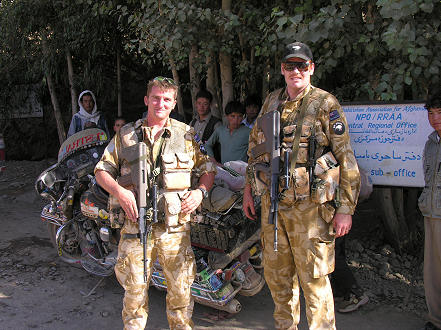 I saw the peace keeping force, ISAF, on my return to Kunduz, in Bamiyan
and in Kabul. The police and military all carry rifles. But in the areas
I visited there was not one negative reaction from anybody, public or officials.
Encounters ranged from blank stares of interest to over enthusiastic welcoming.
I parked the motorcycle in the street for two nights whilst in Mazar-e Sharif,
was told it would be OK and it was. An armed security guard was employed
at the hotel in Kunduz, and the bike was inside the hotel parking in Kabul.
Whilst things are tense between Afghanis, I saw many street arguments, a
couple of people being taken away by police, I never once, even with the
motorcycle accident, felt my dealings would result in anything more than
a discussion. Now seems a great opportunity to visit a country that has been
closed to tourism for so many years and could just as easily close again
for as many more.
I saw the peace keeping force, ISAF, on my return to Kunduz, in Bamiyan
and in Kabul. The police and military all carry rifles. But in the areas
I visited there was not one negative reaction from anybody, public or officials.
Encounters ranged from blank stares of interest to over enthusiastic welcoming.
I parked the motorcycle in the street for two nights whilst in Mazar-e Sharif,
was told it would be OK and it was. An armed security guard was employed
at the hotel in Kunduz, and the bike was inside the hotel parking in Kabul.
Whilst things are tense between Afghanis, I saw many street arguments, a
couple of people being taken away by police, I never once, even with the
motorcycle accident, felt my dealings would result in anything more than
a discussion. Now seems a great opportunity to visit a country that has been
closed to tourism for so many years and could just as easily close again
for as many more.
23/8/05 Hoping the vehicle ferry to Tajikistan might
run more than once a day I was at the Afghan border post at 9 am, opening
time. Again easy paperwork. Whilst ferries took passengers all morning it
wasn't till 2 pm that I could hitch a ride for the motorcycle on a returning
barge that had delivered sugar out of Tajikistan. The cross border trade
is still small, the bags of sugar unloaded on one side by hand and reloaded
onto trucks, again by hand, in Afghanistan. The regular vehicle barge not
leaving Tajikistan till after 2 pm, or Afghanistan till after 3 pm for its
return.
Move with me to Tajikistan
 of the new electrical posts, the only shade. Each village had
a sign, an aid agency, helping with housing or agriculture, different
village, different aid agency. Closer to Kunduz, irrigation occurs, not
only water for plants but for boys swimming and playing in the canals.
It was to be quite some time before I saw a woman, and then it was under
the Burka, the all encompassing robe that covers the face, and the eyes
see only through a cloth mesh. I decided to stay in Kunduz for the night
having been advised not to travel into the evening. I had also been advised
not to wander off the road, even to toilet, as over 100 injuries a month
still occur due to exploding mines and shells.
of the new electrical posts, the only shade. Each village had
a sign, an aid agency, helping with housing or agriculture, different
village, different aid agency. Closer to Kunduz, irrigation occurs, not
only water for plants but for boys swimming and playing in the canals.
It was to be quite some time before I saw a woman, and then it was under
the Burka, the all encompassing robe that covers the face, and the eyes
see only through a cloth mesh. I decided to stay in Kunduz for the night
having been advised not to travel into the evening. I had also been advised
not to wander off the road, even to toilet, as over 100 injuries a month
still occur due to exploding mines and shells.
 However there is an underlying tension. I have seen three street
arguments, one resulting in a blow. Armed police and military patrol
the streets and my hotel has an armed guard protecting the vehicles at
night. Television, also banned under the Taliban, is now in most restaurants,
belly dancers or sports the common theme. There is surprisingly, a lot
of English spoken, and I was guided to change money, easy at almost any
shop, (people wanting cash dollars to buy imported goods), and the internet,
by a friendly English speaking local. My guide informed me that women
were not allowed in the streets under the Taliban unless they had an emergency,
eg medical, but even now only about 5 per cent of people I have seen are
women, and of those 90 per cent still use the burka, the others, almost
exclusively older ladies, might have a head scarf or chador. I sat outside
the restaurant, and feeling quite inconspicuous, took many photographs
of passers-by, and without exception those noticing me photographing them
were comfortable with being photographed. A stroll through the market streets
revealed no women shopkeepers or workers. It is less than four years since
the Taliban fell and things move
However there is an underlying tension. I have seen three street
arguments, one resulting in a blow. Armed police and military patrol
the streets and my hotel has an armed guard protecting the vehicles at
night. Television, also banned under the Taliban, is now in most restaurants,
belly dancers or sports the common theme. There is surprisingly, a lot
of English spoken, and I was guided to change money, easy at almost any
shop, (people wanting cash dollars to buy imported goods), and the internet,
by a friendly English speaking local. My guide informed me that women
were not allowed in the streets under the Taliban unless they had an emergency,
eg medical, but even now only about 5 per cent of people I have seen are
women, and of those 90 per cent still use the burka, the others, almost
exclusively older ladies, might have a head scarf or chador. I sat outside
the restaurant, and feeling quite inconspicuous, took many photographs
of passers-by, and without exception those noticing me photographing them
were comfortable with being photographed. A stroll through the market streets
revealed no women shopkeepers or workers. It is less than four years since
the Taliban fell and things move slowly in traditional societies, and more slowly in rural areas,
but the women here seem to be taking a slow pace to their freedoms.
slowly in traditional societies, and more slowly in rural areas,
but the women here seem to be taking a slow pace to their freedoms. Consequently towns had inserted speed humps to slow vehicles, hundreds
of them. The first ISAF (International Security Assistance Force) personnel
I saw was at an accident, a taxi, always overloaded, crumpled against
a massive 4x4, no seat belts, likely no survivors. ISAF seemed to be just
ensuring the crowd didn't get out of control. Kabul is a busy, dusty, thriving
city in a bowl surrounded by mountains. I haven't seen a native tree, only
planted ones. The houses run up the mountains, built of the same coloured
earth, covered in the same dust they disappear into the haze. I finally
found the Park Hotel, the third I had looked at in traffic jammed downtown,
with motorcycle parking, and like most things here, without the soft touch
and cleanliness of a woman's hand, it is drab, rooms and bathrooms uncleaned
and no maintenance, and
the one sheet on the bed is probably no cleaner than when the last man slept
on it.
Consequently towns had inserted speed humps to slow vehicles, hundreds
of them. The first ISAF (International Security Assistance Force) personnel
I saw was at an accident, a taxi, always overloaded, crumpled against
a massive 4x4, no seat belts, likely no survivors. ISAF seemed to be just
ensuring the crowd didn't get out of control. Kabul is a busy, dusty, thriving
city in a bowl surrounded by mountains. I haven't seen a native tree, only
planted ones. The houses run up the mountains, built of the same coloured
earth, covered in the same dust they disappear into the haze. I finally
found the Park Hotel, the third I had looked at in traffic jammed downtown,
with motorcycle parking, and like most things here, without the soft touch
and cleanliness of a woman's hand, it is drab, rooms and bathrooms uncleaned
and no maintenance, and
the one sheet on the bed is probably no cleaner than when the last man slept
on it.  High heels, lace stockings (seen only below the ankle), and nail
polish appearing. Some will walk alone, but still a long way from a
mini skirt, if that is actually desired? Older men have the traditional
fist length beard, and turban with the loose flowing pants and top. Younger
men wear anything from the above to full western dress, any combination
seems acceptable. Cigarettes are rarely smoked, crushed tobacco is held
under the tongue, spitting is common. I visited the old 1970's area of
Kabul, part of the hippy trail, Chicken St and the Mustafa Hotel. Chicken
Street is a fairly dead place on a Friday holiday, half the shops are shut,
those that are open sell the same products of 35 years ago, carpets, jewellery
and semi historical artefacts, although the chicken shops are now gone, but
the street kids are about trying their luck at begging, selling books or
newspapers or even offering to be your security for a fee. There were a few
group tourists but most of the business is reportedly from NGO's and international
forces. It is easy to compare the differences that war has caused here as
opposed to Khao San Rd in Bangkok, that has continued to grow year on year
since its 1970's beginnings. I am not sure if the Mustafa Hotel is the
same, a quite modern hotel, still attracting the westerners and locals
alike. One of the few places
High heels, lace stockings (seen only below the ankle), and nail
polish appearing. Some will walk alone, but still a long way from a
mini skirt, if that is actually desired? Older men have the traditional
fist length beard, and turban with the loose flowing pants and top. Younger
men wear anything from the above to full western dress, any combination
seems acceptable. Cigarettes are rarely smoked, crushed tobacco is held
under the tongue, spitting is common. I visited the old 1970's area of
Kabul, part of the hippy trail, Chicken St and the Mustafa Hotel. Chicken
Street is a fairly dead place on a Friday holiday, half the shops are shut,
those that are open sell the same products of 35 years ago, carpets, jewellery
and semi historical artefacts, although the chicken shops are now gone, but
the street kids are about trying their luck at begging, selling books or
newspapers or even offering to be your security for a fee. There were a few
group tourists but most of the business is reportedly from NGO's and international
forces. It is easy to compare the differences that war has caused here as
opposed to Khao San Rd in Bangkok, that has continued to grow year on year
since its 1970's beginnings. I am not sure if the Mustafa Hotel is the
same, a quite modern hotel, still attracting the westerners and locals
alike. One of the few places a beer can be had on a Friday, internet and expensive western meals.
a beer can be had on a Friday, internet and expensive western meals. He spoke good English, was of a similar age and certainly had the
quick mind to be the same man. We discussed the book abstractly, and whilst
he denied having read it, he certainly had a great knowledge of its background.
He was pleased to hear my view that the writer seemed to take a particular
feminist angle and that I considered it inappropriate to write such a book
after being invited to live in his home. I purchased a couple of western
novels, reprints from Pakistan, at a discount, which he told me he has never
before given.? The rest of the day was spent at the Mustafa Hotel, photographers,
journalists, NGO's and one other tourist.
He spoke good English, was of a similar age and certainly had the
quick mind to be the same man. We discussed the book abstractly, and whilst
he denied having read it, he certainly had a great knowledge of its background.
He was pleased to hear my view that the writer seemed to take a particular
feminist angle and that I considered it inappropriate to write such a book
after being invited to live in his home. I purchased a couple of western
novels, reprints from Pakistan, at a discount, which he told me he has never
before given.? The rest of the day was spent at the Mustafa Hotel, photographers,
journalists, NGO's and one other tourist. vehicle on the road but could only manage to average 25 km/hr plus
stops, taking eight hours total from Kabul. Again the road followed small
rivers with any flat land cultivated with irrigated snow melt. Bamiyan
is a one street town and I was welcomed by the ISAF soldiers from New Zealand
driving their Hummer, decked out with all the military hardware. The light
on the two enormous Buddha Niches, one 38 metres high the other 55 metres,
was perfect and I rode the motorcycle to their bases for a photograph.
The Buddha themselves, having survived for 1500 years since their construction
in the 6th century, only to be totally destroyed by the Taliban just four
years ago, just months before their government was overthrown. Conservation
work is being done on the remnants, very little, the rubble is being removed.
vehicle on the road but could only manage to average 25 km/hr plus
stops, taking eight hours total from Kabul. Again the road followed small
rivers with any flat land cultivated with irrigated snow melt. Bamiyan
is a one street town and I was welcomed by the ISAF soldiers from New Zealand
driving their Hummer, decked out with all the military hardware. The light
on the two enormous Buddha Niches, one 38 metres high the other 55 metres,
was perfect and I rode the motorcycle to their bases for a photograph.
The Buddha themselves, having survived for 1500 years since their construction
in the 6th century, only to be totally destroyed by the Taliban just four
years ago, just months before their government was overthrown. Conservation
work is being done on the remnants, very little, the rubble is being removed. A pilgrimage site, slowly a local tourist place and a couple of westerners.
This year there are more facilities and we stayed the night in a flat roofed
mud brick room, sleeping on mats on the floor. At 2900 metres the season
is short, less than three months and the air cold, crisp and clear. Locals
were out with their donkeys collecting summer grasses for fuel and stock
feed over winter.
A pilgrimage site, slowly a local tourist place and a couple of westerners.
This year there are more facilities and we stayed the night in a flat roofed
mud brick room, sleeping on mats on the floor. At 2900 metres the season
is short, less than three months and the air cold, crisp and clear. Locals
were out with their donkeys collecting summer grasses for fuel and stock
feed over winter.  Something in this country I find difficult art
the stares. Even in areas where I would have expected enough tourists to
have watered down the novelty locals take long looks at me, and would be
considered by us as being an impolite length of time to look. I walked over
to the Buddha niches, surrounded by caves, a newer town exists where some
people still live in caves or at the base of the cliff, another ruins of
mud brick houses and the more modern town, still of mud brick all show an
incredibly long history in this valley and part of the old silk road.
Something in this country I find difficult art
the stares. Even in areas where I would have expected enough tourists to
have watered down the novelty locals take long looks at me, and would be
considered by us as being an impolite length of time to look. I walked over
to the Buddha niches, surrounded by caves, a newer town exists where some
people still live in caves or at the base of the cliff, another ruins of
mud brick houses and the more modern town, still of mud brick all show an
incredibly long history in this valley and part of the old silk road.  veering towards the edge of the road, its mirror smashed into the fairing,
and its side hit the back end of the motorcycle ripping open the fibreglass
pannier. A glancing blow, I skidded to a halt on the thankfully wide roadside
amongst rocks. The car did not stop. After a few seconds to recompose and
restart the motorcycle I pursued the car. Apologies and asking for forgiveness
from the driver was not sufficient as I figured I was within 20 cm of being
dead had I hit him head on. Another vehicle escorted us to the police station
where over a lengthy three hours, revisiting the accident scene, seeing
the debris on my side of the road and the skid marks put the car driver
completely in the wrong with damages of $US 100.00 to be paid for my damages.
The driver did not have the money. The police officer in charge and another
official offered to pay me, the driver would have to reimburse them. By
now it was dark and I was offered a place in the police compound to camp
the night. The car driver had to remain also at the police compound with
the car while his friends tried to find the money. The $US 100.00 will not
go close to paying for the damages, a new pannier, but is more than most
people here, including the police officer, earn in two months. I was pleased
with the way the police
veering towards the edge of the road, its mirror smashed into the fairing,
and its side hit the back end of the motorcycle ripping open the fibreglass
pannier. A glancing blow, I skidded to a halt on the thankfully wide roadside
amongst rocks. The car did not stop. After a few seconds to recompose and
restart the motorcycle I pursued the car. Apologies and asking for forgiveness
from the driver was not sufficient as I figured I was within 20 cm of being
dead had I hit him head on. Another vehicle escorted us to the police station
where over a lengthy three hours, revisiting the accident scene, seeing
the debris on my side of the road and the skid marks put the car driver
completely in the wrong with damages of $US 100.00 to be paid for my damages.
The driver did not have the money. The police officer in charge and another
official offered to pay me, the driver would have to reimburse them. By
now it was dark and I was offered a place in the police compound to camp
the night. The car driver had to remain also at the police compound with
the car while his friends tried to find the money. The $US 100.00 will not
go close to paying for the damages, a new pannier, but is more than most
people here, including the police officer, earn in two months. I was pleased
with the way the police handled the matter but have mixed feelings regarding the damage or whether
the car driver could pay the compensation. Had he stopped after the accident
or been more honest in the dealings with the police rather than trying to
lie, I may have been more conciliatory.
handled the matter but have mixed feelings regarding the damage or whether
the car driver could pay the compensation. Had he stopped after the accident
or been more honest in the dealings with the police rather than trying to
lie, I may have been more conciliatory. itself dates to the 15th century when a mullah reportedly discovered
the tomb of Ali, son-in-law of the prophet Mohammed, a tomb now the centre
of a grand mosque, and a worshiping place for all Muslims. The city itself
is currently stable but has recently been fought over by warlords wanting
to increase their control of the region. I visited the mosque once the heat
had gone from the day.
itself dates to the 15th century when a mullah reportedly discovered
the tomb of Ali, son-in-law of the prophet Mohammed, a tomb now the centre
of a grand mosque, and a worshiping place for all Muslims. The city itself
is currently stable but has recently been fought over by warlords wanting
to increase their control of the region. I visited the mosque once the heat
had gone from the day. I saw the peace keeping force, ISAF, on my return to Kunduz, in Bamiyan
and in Kabul. The police and military all carry rifles. But in the areas
I visited there was not one negative reaction from anybody, public or officials.
Encounters ranged from blank stares of interest to over enthusiastic welcoming.
I parked the motorcycle in the street for two nights whilst in Mazar-e Sharif,
was told it would be OK and it was. An armed security guard was employed
at the hotel in Kunduz, and the bike was inside the hotel parking in Kabul.
Whilst things are tense between Afghanis, I saw many street arguments, a
couple of people being taken away by police, I never once, even with the
motorcycle accident, felt my dealings would result in anything more than
a discussion. Now seems a great opportunity to visit a country that has been
closed to tourism for so many years and could just as easily close again
for as many more.
I saw the peace keeping force, ISAF, on my return to Kunduz, in Bamiyan
and in Kabul. The police and military all carry rifles. But in the areas
I visited there was not one negative reaction from anybody, public or officials.
Encounters ranged from blank stares of interest to over enthusiastic welcoming.
I parked the motorcycle in the street for two nights whilst in Mazar-e Sharif,
was told it would be OK and it was. An armed security guard was employed
at the hotel in Kunduz, and the bike was inside the hotel parking in Kabul.
Whilst things are tense between Afghanis, I saw many street arguments, a
couple of people being taken away by police, I never once, even with the
motorcycle accident, felt my dealings would result in anything more than
a discussion. Now seems a great opportunity to visit a country that has been
closed to tourism for so many years and could just as easily close again
for as many more.